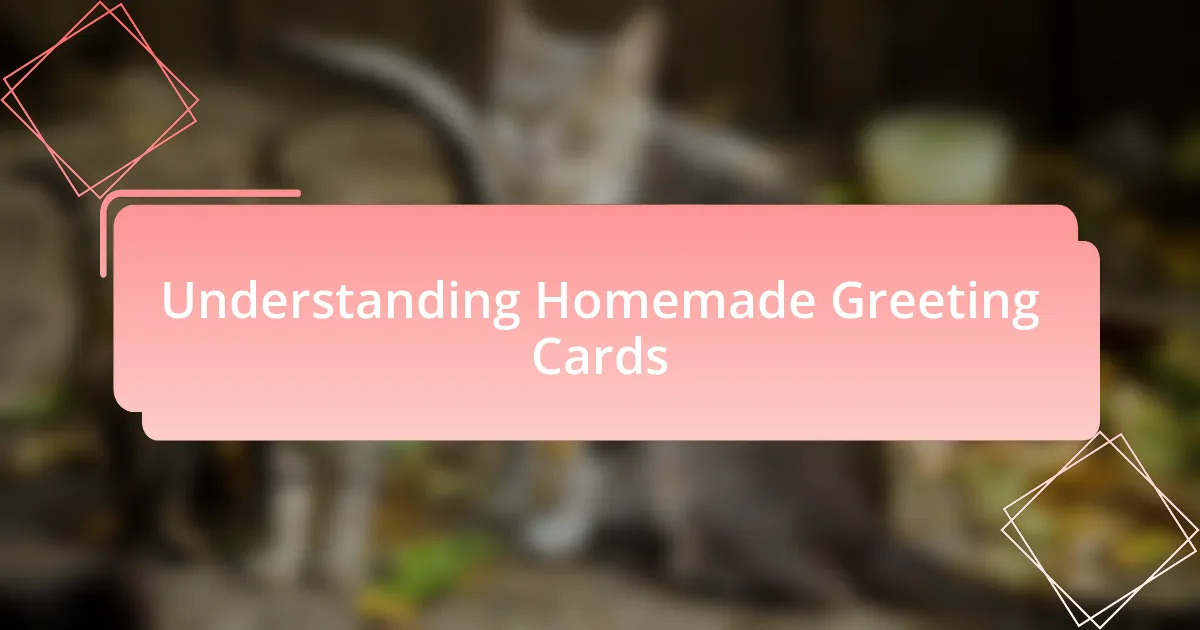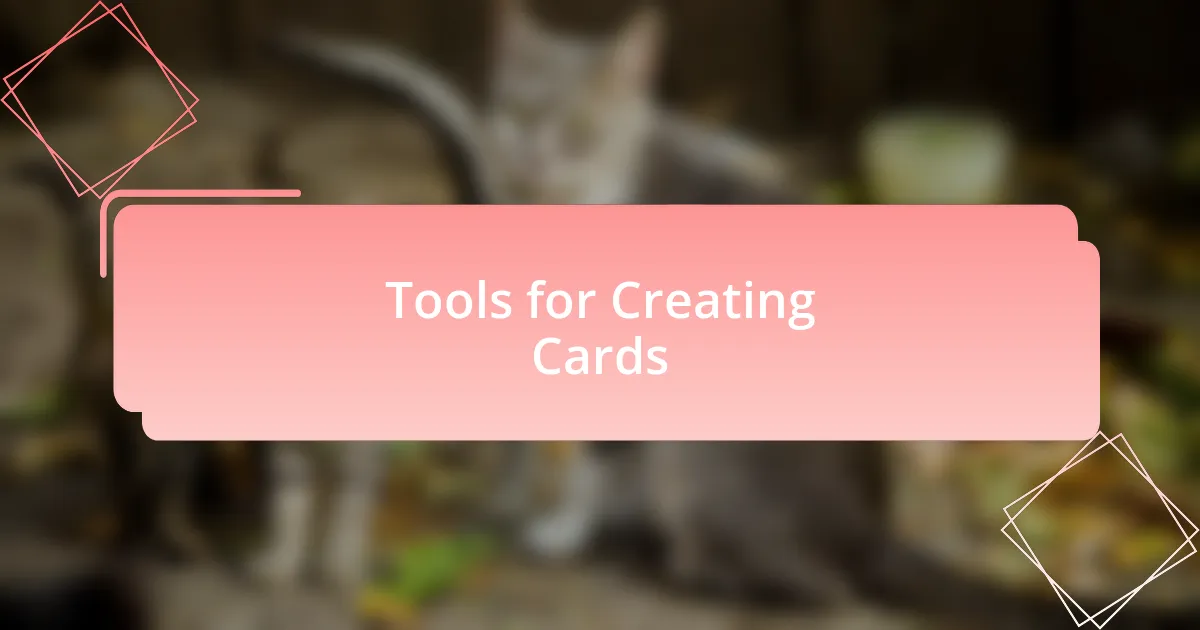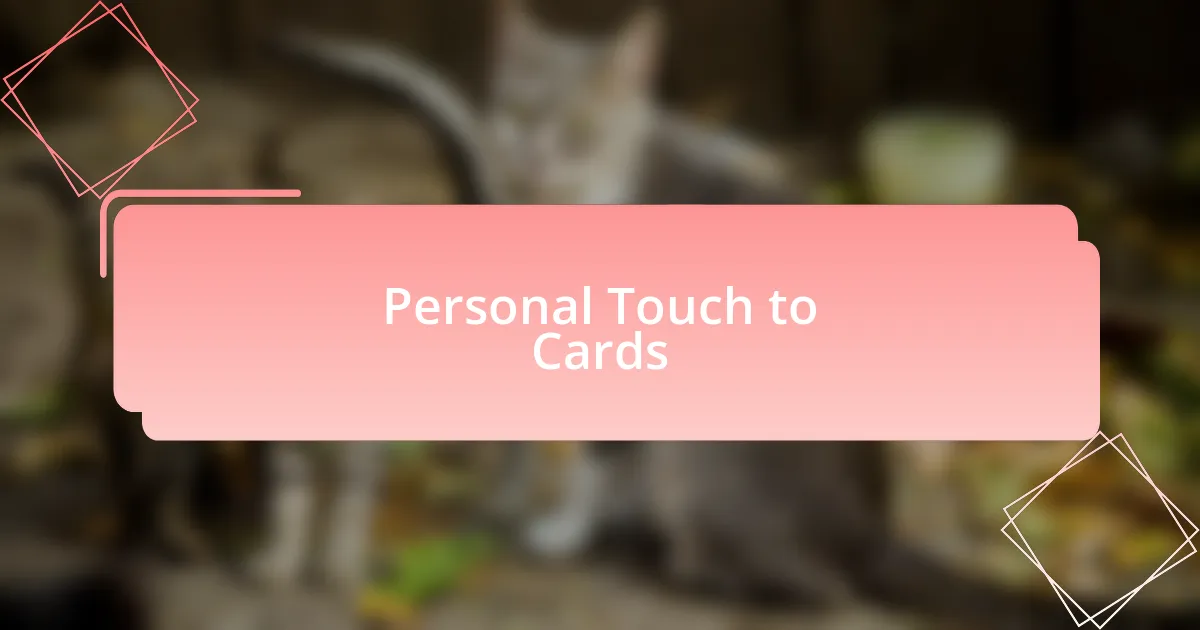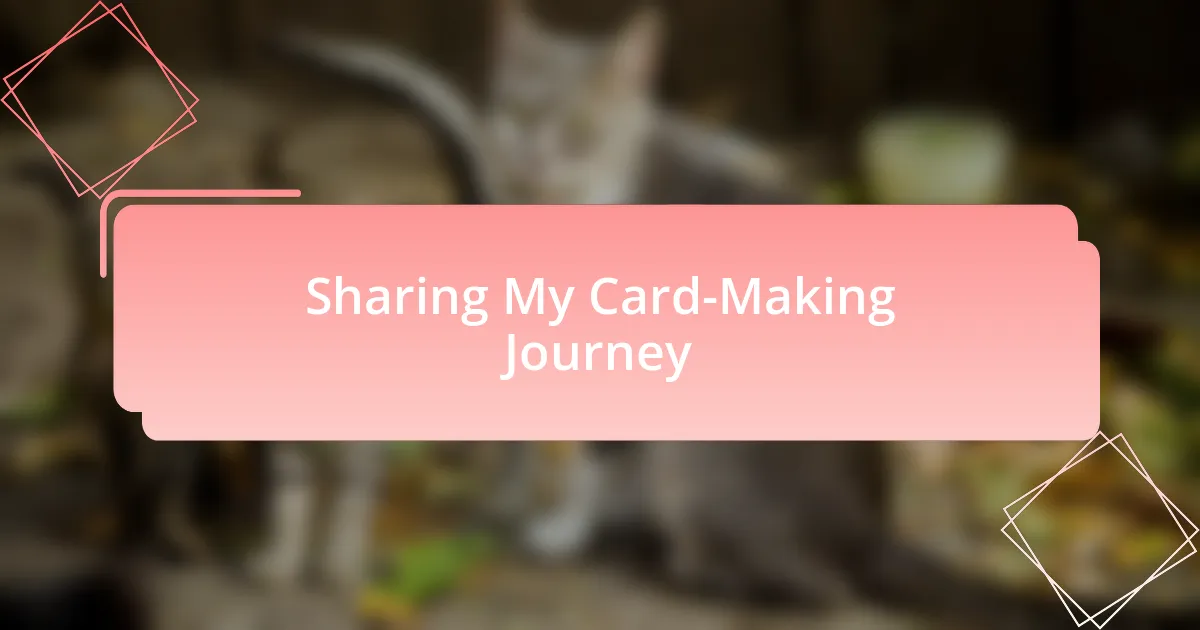Key takeaways:
- Homemade greeting cards offer a personal touch that enhances emotional connection through creativity and sentimentality.
- Incorporating unique materials and personal elements, such as photos or handwritten messages, transforms cards into cherished keepsakes.
- The card-making process allows for mindfulness and reflection, enriching the act of gifting with deeper emotional significance.
- Using thoughtful design choices, like themes and color schemes, can evoke specific emotions and memories, enhancing the overall impact of the card.

Understanding Homemade Greeting Cards
Creating homemade greeting cards is a unique blend of art and emotion. I remember the first Mother’s Day I decided to craft my own card instead of buying one. It felt special knowing that I was pouring my thoughts and creativity into something personal—each handwritten note and doodle was a piece of my heart, making it infinitely more meaningful.
When you think about greeting cards, you might picture glossy store-bought options, but homemade cards carry a warmth that’s hard to replicate. Have you ever opened a card and felt the love in every detail? It’s the imperfections that make them beautiful; a slight smudge or a crooked cut can tell a story of the effort and thought put into it.
Diving into card-making allows for a deeper level of connection. I often find myself reflecting on the memories I want to share while choosing colors or materials that resonate with the recipient. This process is not just about crafting; it’s about creating a keepsake that encapsulates moments and emotions.

Benefits of Homemade Cards
When I think of homemade cards, one of the biggest benefits that comes to mind is the personal touch. I recall a Mother’s Day when I incorporated a small photo collage into my card. It transformed a simple piece of paper into a cherished keepsake for my mom, capturing memories from the past year. Who wouldn’t appreciate receiving a card that tells a story?
Another advantage is the versatility in design and materials. I loved exploring different textures, from glitter to fabric scraps. One year, I even used pressed flowers from our garden, which not only looked beautiful but also carried a sentimental value. Isn’t it fascinating how creativity can turn a card into a unique treasure rather than just a greeting?
Finally, crafting these cards nurtures mindfulness. As I sat down to create, it became a moment of reflection. I’d think about my mom’s favorite colors, the little things she loves, and the memories we share. This practice reminds me that gifting isn’t just about the object itself; it’s about the love and thought behind it. How often do we allow ourselves that space to truly connect with our emotions while creating something for someone we cherish?

Tools for Creating Cards
Choosing the right tools can make all the difference when creating homemade cards. I remember my first card-making experience; I gathered basic supplies like scissors, glue, and colored markers. However, over time, I discovered that investing in specialty items, such as high-quality cardstock and decorative stamps, can elevate your creations to a new level. Have you ever experienced the joy of watching a simple piece of paper transform into something spectacular with just the right tools?
Beyond the basics, I found that embellishments truly add character to my cards. Incorporating washi tape and sequins reflects personal style while making each piece uniquely mine. One year, I attached a little charm to a card, which not only enhanced its visual appeal but also added a tactile element that my mom loved. Isn’t it incredible how these small additions can make a heartfelt note so much more personal?
As I honed my card-making skills, I began to appreciate the creative possibilities with digital tools as well. Using design software like Canva allowed me to play around with layouts and colors before committing to a physical card. I remember being thrilled with the result—printing out a card that looked professionally designed while still carrying that homemade essence. Don’t you love the blend of tradition and modernity in crafting?
Design Ideas for Mother’s Day
When it comes to design ideas for Mother’s Day cards, I love to get creative with themes that resonate personally. One year, I decided to base my card on my mother’s favorite flowers—daisies. I spent hours hand-drawing vibrant petals and adding delicate green leaves, and as I worked, I felt a wave of nostalgia wash over me. Isn’t it fascinating how something as simple as a flower can evoke cherished memories?
Color schemes play a crucial role in setting the mood for your card. I often lean towards soft pastels for Mother’s Day, which create a warm and loving atmosphere. I recall one particularly memorable card where I combined lavender and rose tones; it not only matched my mom’s beautiful garden but also brought a smile to her face. Have you tried experimenting with color palettes to convey specific emotions? It’s an exhilarating process!
Beyond colors and themes, considering different card formats can really enhance your design. One time, I opted for a pop-up card that surprised my mom when she opened it. The joy in her eyes was unforgettable! What about using unusual materials, like fabric or textured paper? These choices can add dimension and make your card physically appealing, showing your mom just how much thought and love went into it.

Personal Touch to Cards
Adding a personal touch to homemade cards can transform them from simple notes into treasured keepsakes. I remember a particularly special card I made by incorporating snippets of a shared favorite song. I handwrote the lyrics on the inside and paired them with small illustrations that represented our memories together. It made the card not just a greeting but a reflection of our unique bond. Have you considered how music, too, can evoke emotions in your creations?
In my experience, including handwritten messages can elevate your card’s intimacy. One year, instead of a standard message, I wrote a heartfelt letter to my mom expressing my gratitude for her unwavering support during tough times. The genuine emotion poured into that letter impacted her immensely. How often do we take the time to articulate our feelings in writing? It’s a powerful way to convey love and appreciation.
Another effective way I’ve personalized my cards is by adding small mementos. For instance, I once attached a pressed flower from her garden alongside my message. The flower not only complemented the card visually but also held sentimental value. Have you tried incorporating such elements into your cards? Even a simple photograph can speak volumes and create lasting memories.

Tips for Writing Messages
When crafting the message for your card, think about what really captures your relationship with the recipient. I recall once writing a simple note to my sister, reflecting on our childhood adventures. Just a few lines about our favorite tree-climbing spots brought back a flood of memories for both of us. How can memories like these inspire your own messages?
Another tip is to be sincere and authentic in your writing. I remember a time when I wrote a message from the perspective of how much my mom’s strength and resilience had influenced my life. Instead of generic well-wishes, I shared specific instances that shaped my appreciation for her. This approach not only deepened our connection but also made the card feel more meaningful. Have you thought about how specific memories could elevate your own messages?
Lastly, consider wrapping up your message with a personal touch, such as a special quote or saying that resonates with you both. In one card, I shared a quote about love that perfectly encapsulated my feelings for my grandmother. She always said that words have the power to heal, and that quote became a bridge between us. What words or phrases hold special meaning in your relationship that you could incorporate into your card?

Sharing My Card-Making Journey
Creating homemade greeting cards has been a delightful journey for me, and there’s something inherently satisfying about crafting each piece. I remember the first time I sat down with a stack of blank cards and a rainbow of colored pens. Each stroke felt like penning a little piece of my heart onto the paper. What if every card could tell a story?
As I progressed, I began incorporating various materials, like glitter and fabric scraps, to add texture and dimension. I recall making a card for my mom where I glued bits of lace and pressed flowers from her garden. It was more than just a card; it was a collage of our shared life. Have you ever considered how adding personal elements can transform a simple greeting into a cherished keepsake?
In my experiences, I’ve learned that the card-making process is just as important as the final product. Often, I’ll find myself reminiscing while I craft, letting memories guide my creativity. One time, while making a birthday card, I reflected on the laughter we shared during family celebrations. It made me wonder—what memories are embedded in the cards you create?